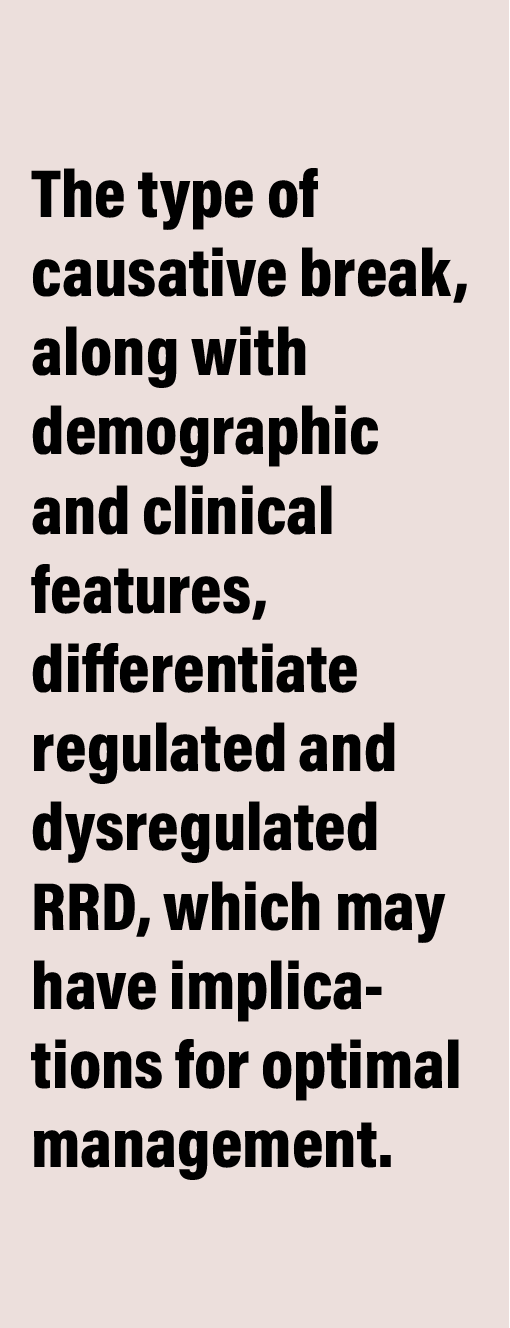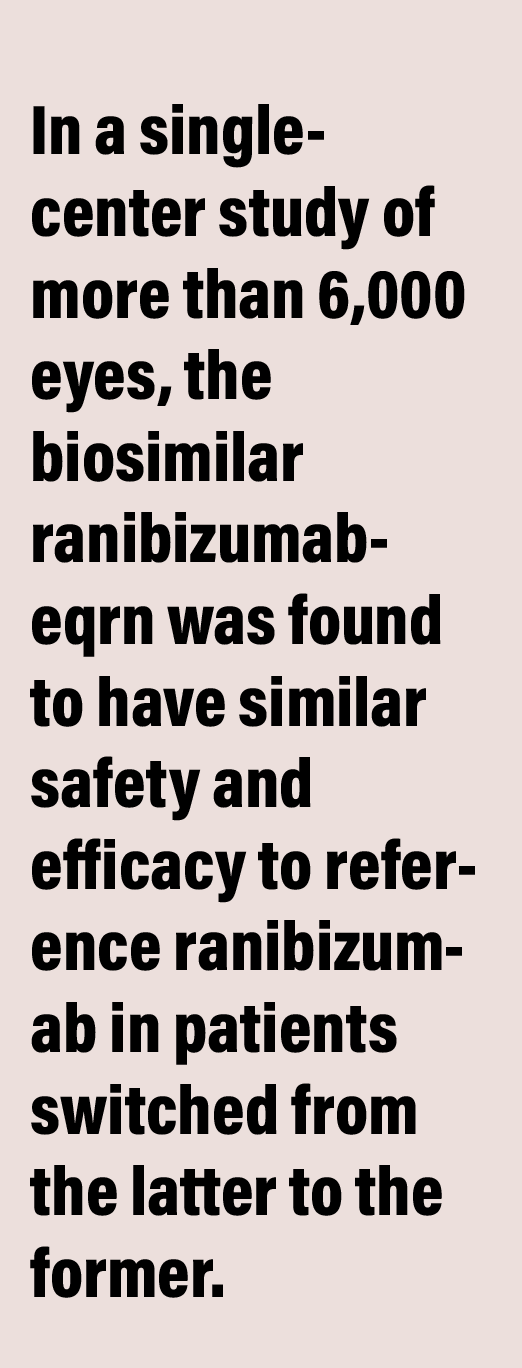 |
|
Bio Dr. Bommakanti is a vitreoretinal surgery fellow at Wills Eye Hospital/Mid Atlantic Retina, Philadelphia. DISCLOSURES: Dr. |
The American Society of Retina Specialists crossed the pond to Stockholm for the 42nd iteration of its annual scientific meeting, which featured a multitude of trial readouts and reports on novel biomarkers and diagnostic techniques.
Retinal ischemic perivascular lesions a stroke biomarker in AF
 |
Investigators at Yale School of Medicine in New Haven, Connecticut, set out to determine whether retinal ischemic perivascular lesions (RIPLs), an optical coherence tomography biomarker of subclinical retinal ischemia, are associated with stroke in individuals with atrial fibrillation.1
Mathieu Bakhoum, MD, PhD, a retina specialist at Yale, and colleagues conducted a retrospective, cross-sectional study of 178 adults aged 50 to 90 years diagnosed with atrial fibrillation who had a macular OCT scan.
RIPLs were present in 41 percent of the patients and 16.9 percent had a stroke or transient ischemic attack. The researchers found no significant difference in anticoagulation use between patients who did and didn’t have stroke or TIA.
A univariate analysis found that those with RIPLs had a three times greater risk of stroke (OR 3.01; 95% CI 1.33, 6.79, p=0.008). In a multivariable logistic regression model adjusting for age, sex, anticoagulation use, presence of hypertension, diabetes mellitus, vascular disease and congestive heart failure determined patients with RIPLs had a similar risk for stroke or TIA (OR 2.88; 95% CI 1.23, 6.98, p=0.016).
Using OCT to evaluate RIPL improves stroke risk stratification in patients with AF beyond the conventional clinical risk factors, Dr. Bakhoum said.
Dr. Bakhoum has no relevant financial disclosures.
OCT may identify potential ROP risk factor
 |
Popcorn neovascularization occurs in higher-risk infants and may be an independent risk factor for retinopathy of prematurity progression. Isolated NV tufts are a common finding in patients with stage 2 and 3 ROP, noted J. Peter Campbell, MD, MPH, a pediatric retina specialist at Oregon Health and Science University (OHSU) Casey Eye Institute in Portland. He reported on a retrospective case series to more deeply explore classifying the course and significance of “popcorn” NV lesions in patients with ROP. 2
The study used a prototype ultra-widefield optical coherence tomography device to captured en face scans (>140 degrees visual angle) from 136 babies in the neonatal intensive care unit at OHSU from December 2020 to August 2023. Their parents consented to participate in the study, but the study didn’t account for demographic risk factors or other clinical confounders.
The investigators reviewed all images for the presence of popcorn NV along with standard zone, stage and plus classification. They used a cross-sectional analysis to compare eyes with and without popcorn by birth weight, gestational age and zone of ROP at the time of diagnosis.
Of the 64 patients with at least stage 2 ROP during their disease course, 22 (34 percent) developed popcorn NV. On average, patients with popcorn had lower birth weights (660.1g vs. 916.8g, p=0.001), lower gestational age (24.9 vs 26.1 weeks, p=0.01), and were more likely to present with zone 1 ROP (63.4 vs. 15.8 percent, p<0.001). They were also more likely to progress to stage 3 (68.2 vs 13.2 percent, p<0.001) and receive treatment (54.5 vs. 15.8 percent, p=0.002).
In the 13 babies who had images preceding onset of stage 3, popcorn developed significantly earlier on average than stage 3 (35 vs. 37.5 weeks, p=0.04). Among eyes with stage 2 or 3 ROP at some point in their disease course, eyes with popcorn had a higher clinician-assigned peak vascular severity score than those without (5.9 vs. 4.2, p=0.006) On multivariable logistic regression, popcorn was independently associated with progression to stage 3, controlling for gestational age, birth weight and initial zone 1 disease.
Dr. Campbell noted that UWF-OCT was useful to visualize the progression of popcorn NV lesions and may help identify high-risk patients. Longitudinal monitoring of these lesions may be useful to better understand the pathophysiology of NV in ROP, he said.
Dr. Campbell is the owner of Siloam Vision.
 |
Outer retinal corrugations may define regulated, dysregulated RRDs
Researchers in Toronto reported that swept-source OCT was able to detect significant morphologic differences between regulated and dysregulated rhegmatogenous retinal detachments.3 Rajeev Muni, MD, MSC, of the University of Toronto and St. Michael’s Hospital, reported that outer retinal corrugations (ORCs) are present in almost all dysregulated cases, but in only a few regulated cases.
The prospective cohort study included 122 eyes with RRDs, 21.3 percent (n=26) of which were classified as regulated and 78.7 percent (n=96) as dysregulated.
In patients with an identified causative break, horseshoe tears were absent in all regulated RRDs, but were observed in 87.3 percent of all dysregulated RRDs (p<0.001). Atrophic or small retinal holes were detected in all cases of regulated RRDs vs 12.5 percent of dysregulated ones (p<0.001).
OCT detected ORC in 3.8 percent of regulated vs. 84.4 of dysregulated RRD eyes (p<0.001). Cystoid macular edema was found in 50 percent of eyes with regulated RRD compared to 87.2 percent of eyes with dysregulated RRD (p<0.001).
Among patients with regulated RRDs, 31.3 percent were predominantly in Stage 2, none in Stage 3A, 6.3 percent in Stage 3B, none in Stage 4, and 62.5 percent in Stage 5.
In patients with dysregulated RRDs, 14.9 percent were in Stage 2, 16 percent in Stage 3A, 38.3 percent in Stage 3B, 23.4 percent in Stage 4, and 7.4 percent in Stage 5 (p<0.001).
The type of causative break, along with demographic and clinical features, differentiate regulated and dysregulated RRD, which may have implications for optimal management, Dr. Muni said.
Dr. Muni disclosed financial relationships with Bayer, AbbVie, Alcon, Apellis Pharmaceuticals, Precision Retina, Novartis, Bausch + Lomb, and Roche.
 |
CRA message may restore perfusion on CRAO
Nishikant Borse, MS, FMRF, of the Insight Eye Clinic, noted that a surgical intervention for CRAO has gained interest because conventional therapies have a limited role in CRAO management.
 |
The surgical technique consisted of a three-port pars plana vitrectomy with 23- or 25-gauge needles, a low intraocular pressure vitrectomy, with infusion pressure at 8 to 10 mmHg
and vacuum at 100 to 150 mmHg to prevent globe collapse. The low IOP during vitrectomy achieves an effect similar to paracentesis, Dr. Borse said. A prolonged and sustained hypotony that helps to improve perfusion is possible only by performing a vitrectomy, he said.
A complete posterior vitreous detachment is induced, a somewhat “tricky” maneuver during a low-IOP vitrectomy, Dr. Borse said. However, the PVD improved perfusion in the capillaries surrounding the disc. In all 48 cases, an absence of PVD was the single most common finding.
Following the vitrectomy, the peripapillary internal limiting membraned was stained using Brilliant Blue G dye. The ILM dissection was continued onto the optic disc. This was followed by a massage of the CRA and its branches radially from center to the periphery over the optic disc.
If the arterial sheath was thick, a careful sheathotomy was performed using end-gripping forceps. The sheathotomy was performed from the disc center at the origin of the CRA to the periphery in a radial fashion along the CRA branches.
If this maneuver succeeds, the retinal perfusion improves and the CRA can be seen pulsating at the level of the lamina, Dr. Borse noted. In many cases, further massage can result in the dislodgement of the causative embolus, which can be visualized migrating to the retinal peripheral circulation. Thus, low IOP during the procedure is imperative, he said. The eye has to be left hypotonic at the end of the surgery.
In the 48 patients Dr. Borse reported on, preoperative visual acuity in the affected eyes ranged from 20/400 to counting fingers. One month after surgery, visual acuity in 15 eyes (31 percent) had improved to >20/120; and in seven eyes (15 percent) to >20/200. Three eyes had a minimal VA visual improvement to 20/400. The remaining 23 eyes (48 percent) had no change in VA. VA rarely continued to improve beyond one month.
The results, Dr. Borse said, showed that mean logMAR visual acuity had improved from 1.61 at baseline 1.24 at one month. The difference between logMAR VA preoperatively and at one month postoperatively (−1.6 vs. −1.25, p=0.00000361) was statistically significant.
As for anatomical outcomes, retinal perfusion had significantly improved in 28 eyes by the end of the procedure. In nine eyes the causative embolus was successfully dislodged from the CRA to the retinal periphery. Preoperative fluorescein angiography showed that the arm-retina times were significantly below normal in all eyes with CRAO. FA three days after cannulation revealed complete reperfusion and incomplete but improved retinal reperfusion in 25 eyes.
Postoperative OCT demonstrated that the hyperreflective subretinal band had disappeared in eyes with successful reperfusion. However all the eyes showed some degree of retinal atrophy one month after even a successful surgery, due to the hypoxic insult, Dr. Borse said.
Dr. Borse disclosed financial relationships with Bayer India and Novartis India.
Efficacy, safety equivocal post-ranibizumab biosimilar switch
 |
In a single-center study of more than 6,000 eyes, the biosimilar ranibizumab-eqrn (RZE) (Cimerli, Sandoz) was found to have similar safety and efficacy to reference ranibizumab (Lucentis, Genentech Roche) in patients who were switched from the latter to the former. This is the first switching study of ranibizumab from clinical practice.5
The study by our group at Wills Eye Hospital involved a retrospective chart review of 6,717 eyes from 5,800 patients treated between November 2022 and December 2023 (RZE was approved in June 2023). Of those, 4,938 (73.5 percent) eyes had neovascular age-related macular degeneration, 1,193 (17.8 percent) had retinal vein occlusion and 586 (8.7 percent) had diabetic macular edema.
Eyes received 3.4 ±1.7 (total: 23,171) ranibizumab over 4.4 ±2.2 months. After switching, eyes received 2.5 ±1.2 (total: 16,688) RZE over 2.6 ±1.6 months (p<0.05). The ranibizumab group had no cases of endophthalmitis, the RZE group two (p>0.05).
Of the 2,444 eyes from 2,392 patients with at least three months of follow-up before and after the switch, change in central foveal thickness was -87 ±4015 (median 0) for ranibizumab vs.
-6 ±102 (median 0) for RZE (p>0.05). Change in visual acuity was 0.01 ±0.29 for ranibizumab vs. 0.00 ±0.25 for RZE (p>0.05). Subanalyses by indication yielded similar results.
Dr. Bommakanti has no relevant disclosures.
 |
Largest study of in-office pneumatic retinopexy for RRD shows use and success rate rising
A database study that used the American Academy of Ophthalmology’s Intelligent Research in Sight Registry may be the largest study to date evaluating the use of pneumatic retinopexy for in-office repair of rhegmatogenous retinal detachment.6
Gaurav Shah, MD, a retina specialist at West Coast Retina Medical Group, presented results of a nonrandomized retrospective cohort study of eyes with retinal detachment with retinal break. Dr. Shah noted that in-office PR is an alternative or adjunct to vitrectomy or scleral buckling, but PR may offer comparatively shorter recovery time, decreased cost, and lower risk of cataract progression.
The study evaluated 16,688 unique eyes that had PR for RRD from 2013 to 2022.
Nearly 90 percent of PRs were performed by retina specialists, and 43 percent of eyes were pseudophakic at baseline. The use of PR increased each year from 864 eyes in 2013 to 1,994 eyes in 2017, leveling off at about 2,000 a year from 2018 to 2021, and decreasing to 1,578 eyes in 2022.
The single-operation success rate was 59.5 percent, Dr. Shah reported. Median time to 20/40 best-corrected visual acuity or better was 231 days. Following PR, 1,741 eyes (10.4 percent) developed vitreous hemorrhage, 7,240 (43.4 percent) developed epiretinal membrane, and 54 (0.32 percent) developed endophthalmitis.
The Ophthalmic Mutual Insurance Co., through the Bruce Spivey Fund, provided funding for the study. Dr. Shah disclosed financial relationships with Zeiss and Regeneron. RS
REFERENCES
1. Bakhoum MF. The association between retinal ischemic perivascular lesions and stroke in individuals with atrial fibrillation. Paper presented at American Society of Retina Specialists annual meeting; July 18, 2024; Stockholm, Sweden.
2. Campbell JP. Clinical characteristics and prognosis of eyes with popcorn neovascularization in retinopathy of prematurity observed using ultra-widefield optical coherence tomography. Paper presented at ASRS; July 18, 2024; Stockholm, Sweden.
3. Muni RH. Morphologic features and implications of regulated vs dysregulated rhegmatogenous retinal detachment using swept-source optical coherence tomography. Paper presented at ASRS; July 20, 2024; Stockholm, Sweden.
4. Borse N. Surgical and visual outcomes of vitrectomy with central retinal arterial massage in cases of central retinal artery occlusion. Paper presented at ASRS; July 20, 2024; Stockholm, Sweden.
5. Bommakanti N. Safety and efficacy of switching to biosimilar ranibizumab in eyes initially treated with reference ranibizumab for nAMD, DME, or RVO. Paper presented at ASRS; July 20, 2024; Stockholm, Sweden.
6. Shah GK. IRIS Registry outcomes of pneumatic retinopexy for rhegmatogenous retinal detachment. Paper presented at ASRS; July 17, 2024; Stockholm, Sweden.



